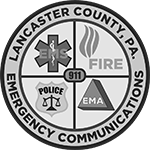911 Telephone Surcharges
Much of LCWC's funding is provided by 911 surcharges on traditional wireline, wireless and voice-over-IP (VoIP) telephone lines. These surcharges are collected by your service provider(s) and appear as a fee(s) on your billing statement.
A uniformly monthly fee of $1.65 is assessed regardless of the wireline, wireless, or VoIP service you may use.
Why the $1.65 surcharge?
Act 12 of 2015: 911 Emergency Communication Services establishes provisions for the formation of a Statewide 911 emergency telephone system. The act is designed to provide a toll-free telephone number (911) for individuals within the Commonwealth of Pennsylvania in order to gain rapid, direct access to emergency aid. Development, deployment, upgrade, maintenance, and operation of 911 systems remain a county responsibility, under county ownership and control.
The act also includes comprehensive revision of governance mechanisms, accountability mechanisms, technology references, distribution of fees, and rate of fees. It recognizes that the commonwealth and counties need not just maintain current 911 systems, but invest in the future response capabilities based on technologies, as well as citizen and corporate expectations.
I have one (1) wireline telephone number, but several remote handsets in my home. Will I be charged for each one of them?
No, you will only be charged on the number of wireline telephone lines (different numbers) in your home.
My family uses a number of wireless handsets, each with a different number. Will I be charged for each one of them?
Yes, your wireless provider(s) should equally assess a fee on each handset. Each handset operates independently and all are capable of dialing 911 simultaneously.
I have multiple telephone lines, are there any cost breaks for this?
Yes, stepped rates exist for multiple dial tone access lines. Refer to Act 12 of 2015: 911 Emergency Communication Services and research your particular situation.
Does everyone have to pay the contribution rate?
If your wireline, wireless, or VoIP service is capable of dialing 911 then, yes, you should be assessed a fee by your provider(s).
Why not charge on an as-needed basis or per call back to the calling party?
This mechanism of payment was evaluated by the legislature and was found to be inadequate and defeated the purpose of 911 services. The intent of the act was to make 911 available to all citizens and visitors in Pennsylvania thereby allowing persons in an emergency, who are under considerable stress, easy access to emergency services at a reasonable cost. Very high service charges, or a significant shortfall in paying for 911 service, would result if charges were made on an as-needed basis or per call. That would have a negative impact on low and moderate income households and those persons on a fixed income.
Is the telephone fee a unique funding method?
No, this funding method for providing 911 service is not unique to the Commonwealth of Pennsylvania. Virtually all of the states assess technology fees to support 911 service.
I thought this charge was only for 911 services. What does Computer-Aided Dispatch (CAD) or a Geographic Information System (GIS) have to do with this?
The utilization of CAD and GIS with a 911 system allows for the most rapid dispatch of appropriate emergency services to the call for help from the citizens and visitors in Lancaster County. The 911 system provides the location of the caller to the CAD system which, in turn, provides the dispatcher with a listing of emergency equipment to send to the caller's location. Additional information like previous calls at the same address, standard operating procedures for the type of call or complaint entered by the call taker, priority listing of calls in the event of multiple calls during natural or technological emergencies, and automatic replacement of units that are out-of-service may be accomplished through the CAD system.
GIS receives the location of the call at the same time as the dispatcher and the CAD system. GIS provides the dispatcher with a map display of the approximate location of the call along with a display of the surrounding area from information provided by the tax assessment office, recorder of deeds, planning commission, emergency management agency, utilities, and other agencies in Lancaster County. GIS also provides the location of the emergency equipment or the location of the nearest water source from ponds, creeks, or hydrants.
Products of GIS also help in the maintenance of the Master Street Address Guide (MSAG) which is an integral part of the 911 system database. The MSAG contains all streets and address ranges of telephone subscribers within Lancaster County. The MSAG validation involves the cooperation of all municipalities and telephone companies in Lancaster County in addition to various county agencies. The telephone company provides the initial information to the county for all telephone subscribers and LCWC validates and assigns an Emergency Service Number (ESN) to each unique jurisdictional area and updates the information on a continual basis when new roads are constructed or names changed.


